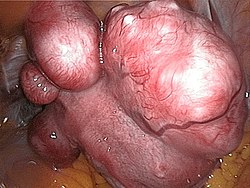Myoma
This article needs more reliable medical references for verification or relies too heavily on primary sources. (July 2019) |  |
| Myoma | |
|---|---|
 | |
| Uterine fibroids | |
| Specialty | Oncology |
Myomas are benign, monoclonal tumors of the smooth muscle cells of the myometrium. They are composed of large amounts of extracellular matrix containing collagen, fibronectin, and proteoglycan. Collagen type I and type III are abundant, but the collagen fibrils are formed abnormally. The presence of myomas is related with fertility. The presence of submucous myomas decreases fertility, and their removal increases fertility to baseline rates. Neither intramural nor subserosal myomas appear to affect fertility rates, and their removal has not been shown to increase fertility. Myomas in pregnancy can affect myoma growth, dependent on individual differences in genetics, circulating growth factors, and myoma-localized receptors. However, most myomas do not increase in size during pregnancy. Morover, 5% of myomas degenerates during pregnancy. [1] They are of two types.
- The leiomyoma occurs in the skin or gut but the common form is the uterine fibroid.
- Rhabdomyomas are rare tumors of muscles, they occur in childhood and often become malignant.
Diagnosis
Clinically significant subserosal and intramural myomas can usually be diagnosed by pelvic examination based on findings of an enlarged, irregularly shaped uterus. However, the optimal selection of patients for medical therapy, noninvasive procedures, or surgery depends on an accurate assessment of the size, number, and position of myomas. The techniques available for confirming the diagnosis of myomas include sonography, saline-infusion sonography, hysteroscopy, and MRI. Transvaginal sonography is the most readily available and least costly technique and may be helpful for differentiating myomas from other pelvic conditions. Saline-infusion sonography uses saline inserted into the uterine cavity to provide contrast and better define submucous myomas, polyps, endometrial hyperplasia, or carcinoma. Magnetic resonance imagine is an excellent method to evaluate the size, position, and number of uterine myomas and is the best modality for exact evaluation of submucous myoma penetration into the myometrium. Magnetic resonance imaging may differentiate adenomyosis from myomas. [2]
Treatment
To remove the tumor from the body, a myomectomy or hysterectomy is often required, depending on the site and type of myoma.
